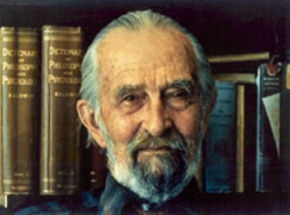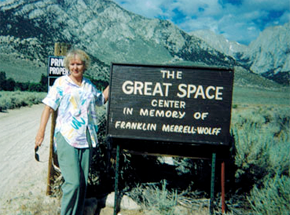Franklin Merrell-Wolff
Biography of Franklin Merrell-Wolff1 (1887-1985) by Ron Leonard
For a full biographical treatment, see Doroethy Leonard’s Franklin Merrell-Wolff: An American Philosopher and Mystic.2 The succinct version here allows a glimpse of this fascinating person to understand better the context of his life’s theme—as he says, “the tendency to drive toward the Root… from which all comes.3 Bear in mind, however, that Franklin wanted to be known for his philosophy, lest his personal story might serve as a distraction from what he considered to be of overriding importance.

Franklin as a Young Boy*
Franklin Fowler Wolff was born in 1887, in Pasadena, California. As the son of a Methodist minister, he was raised with a deep and abiding sense of the religious and ethical dimensions of human existence. By adolescence, his growing autonomous development of intelligent and reflective inquiry began to probe the doctrines of orthodox Christianity; the lack of adequate answers soon led to its rejection. He remarks, “I had been through the orthodox church and found it utterly barren, so far as cognitive values were concerned, and puny in what it offered for feeling.4 Although religious fulfillment remained his primary value, he began to develop his mind through academic studies at Stanford and Harvard.
To prepare for his intended law career, Franklin chose a multidisciplinary approach at Stanford, majoring in pure mathematics, with philosophy and psychology minors. Mathematics stimulated his intellect—he refused to rest until he had solved every problem. More significantly, he discovered mystical and numinous value there, noting that “the feeling persisted that at the root of mathematics there lay a mystery, reaching far deeper than anything attained through the senses.5 His study of the mathematics of the transfinite revealed a profound beauty and harmony, whose quality of delight he says was superseded only by Realization.
Eventually, his need for clarity of understanding required a shift of emphasis to philosophy (in a joint major with mathematics), as he pursued graduate studies at both Stanford and Harvard, having lost any interest in law. At Stanford he won a special one-year scholarship for studies at Harvard, where he attended during the 1912–13 term.

Franklin Graduates from Stanford in 1911*
Franklin found that “philosophy added reflecting and focusing power to the pure light of mathematics.6 Here, the term pure light should be taken to mean intellectual illumination, with adumbrations of mystical consciousness, which may be induced by contemplating a priori relationships. This contrasts to Illumination as Realized or Awakened Consciousness.
His study of analytic psychology provided a different kind of value. He came to appreciate the importance of introspection and developing the skill for the subsequent clear articulation of experience. Mystics rarely leave a personal record of their experiences, so the comprehensive account that Franklin has provided is invaluable.
From his Harvard seminars on Metaphysics and Kant, his conviction grew that a transcendent way of consciousness beyond the comprehension of Western epistemology and psychology probably existed. 1914 was a pivotal year for Franklin. He had been offered a temporary position at Stanford as a replacement for his mathematics supervisor during his sabbatical. A promising academic career in philosophy or mathematics was all but assured; yet, he found himself compelled to abandon it in order to attain a third cognitive function or faculty of cognition transcending perception and conception. He states, “I found myself in sight of the limits to which our present egoistic consciousness has reached, and also had found adumbrations of another kind of Consciousness where alone, it seemed, solution of the antinomies of the subject object consciousness could be found.7 He was confident that in this new mode of consciousness lay the key to metaphysical knowledge, which Kant had shown to be impossible if cognition is limited to the two familiar forms—namely, perception and conception.
Forgoing outer recognition, success and security, Franklin displayed single-minded dedication to the project. Repeatedly he abandoned efforts in a particular direction once he had exhausted its essential value. The twenty-four long years that ensued before his breakthrough were characterized by a vast broadening of experience and activity in the world while he gradually strengthened his commitment.
Although he was a conscientious objector to violent conflict, he served as a Sergeant in World War I, producing lumber for the war effort. He built a house in San Fernando, where he tended orchards and kept bees—skills he had learned from his father. Later, while prospecting during the Great Depression, he found the solitude and archetypal settings of cave and desert powerful catalysts for his final two preliminary mental Realizations.
In 1920 he married Sarah Merrell Briggs, a union that was to prove exceedingly fruitful. To symbolize their complementary, but equal status in their work, they joined their original surnames as “Merrell-Wolff.” The Assembly of Man, which Franklin and Sherifa founded in 1928, had an esoteric philosophical orientation, generally Theosophical in nature, having a basis in the Vedanta and Buddhism.

View of Ashrama Up Tuttle Creek Canyon
The following year, the group obtained permission to build an Ashrama.8 There they held yearly conventions while completing its construction—a project that continued every summer for over twenty years. They erected it at the eight thousand foot level in Tuttle Creek Canyon, nestled in the eastern slope of the Sierra Nevada mountains, between what was to become Franklin’s home, two thousand feet below, and Mt. Whitney (the tallest peak in the contiguous forty-eight states). They purposely chose this location in harmony with the spiritual significance they felt was associated with the highest point within a country. In addition, they designed the structure in the shape of a balanced cross to symbolize the principle of equilibrium.
During this phase, he sometimes experienced periods of self doubt in which he questioned the wisdom of renouncing the security and status of the academic world for the prospect of greater attainment. However, all uncertainty vanished upon his discovery of Shankara, in Paul Deussen’s The System of the Vedanta,9 with whom he immediately felt a profound rapport. He felt that this held the key to his breakthrough—the Fundamental Realization of 7 August 1936.

Franklin Merrell-Wolff in 1936*
Henceforth, Franklin began writing, not merely about Transcendental Consciousness, but from it. Because he intends Pathways through to Space10 to be primarily an autobiographical report on the process itself, including spontaneous reflection on a variety of topics and issues, he presents the philosophical dimension informally, rather than systematically. He is sharing the journey, which may provide personal inspiration for the reader’s spiritual path. In contrast, he attempted to systematically organize “Concept, Percept and Reality”11 and his original manuscript, The Philosophy of Consciousness without an Object,12 so as to satisfy the academic philosopher as well as the learned nonprofessional.
Franklin’s group work and public lectures during the second half of his life had significantly increased effect. Those who knew him well found that as a result of Enlightenment his presence carried a force that could induce exalted states of consciousness, as well as psycho-physical heat, in his audience. That he now could speak with authority concerning the nature and effects of Fundamental Realization he considers of central importance.
Sherifa continued as a partner in his work until her death in 1959. The following year, at the age of seventy-two, Franklin married Gertrude Adams and undertook the construction of a house in the Sierra Nevada mountains, 2000 feet below the Ashrama and 2000 feet above Lone Pine, California. After she died in 1978, he continued to live there (with the assistance of a series of students and family members) until his death on 4 October 1985, at the age of ninety-eight.
To the residents of the town he was a respected, though mysterious, figure who became somewhat legendary, but for those of his group he was an Enlightened spiritual teacher and special friend. Moreover, a great number of his visitors, coming from as far as Australia and Nepal, were drawn by his books. Annual conventions, begun in 1929, continued to attract many people, representing a wide range of ages, occupations and religious backgrounds—including many outstanding professionals from various fields. The remarkably eclectic nature of those who are interested in his work is explained by his philosophy’s profound universal ground and synthetic power, for it recognizes the value of diverse, unique expressions of the spiritual dimension of humankind. Even though it is rooted in Mystical Realization, Franklin emphatically insists that Introceptualism is not, nor must it ever become, a religion.


